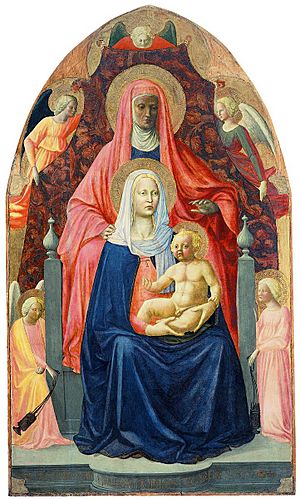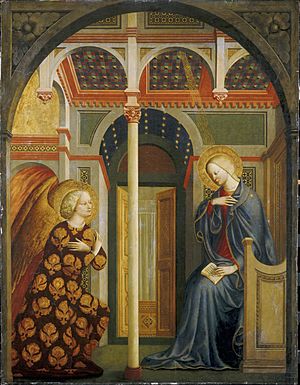Masolino da Panicale facts for kids
Quick facts for kids
Masolino
|
|
|---|---|
 |
|
| Born |
Tommaso di Cristoforo Fini
c. 1383 Panicale
|
| Died | c. 1447 |
| Nationality | Italian |
| Known for | Painting, fresco |
|
Notable work
|
frescoes in the Brancacci Chapel |
| Movement | Italian Renaissance |
| Patron(s) | Pipo of Ozora Cardinal Branda Castiglione |
Masolino da Panicale (born Tommaso di Cristoforo Fini; around 1383 – around 1447) was an important Italian painter. He lived during the exciting time of the Italian Renaissance.
Masolino is most famous for his teamwork with another great painter named Masaccio. Together, they created amazing artworks. Their best-known pieces are probably the painting Madonna with Child and St. Anne (from 1424) and the beautiful wall paintings (called frescoes) in the Brancacci Chapel (painted between 1424 and 1428).
Contents
Masolino's Life Story
Masolino, whose nickname means "Little Tom," was likely born in a town called Panicale, near Florence, Italy. When he was younger, he might have worked as an assistant to a famous artist named Lorenzo Ghiberti in Florence, between 1403 and 1407.
In 1423, Masolino officially joined a group for artists in Florence. It was called the Arte dei Medici e Speziali, which included painters. Some people believe he might have been one of the first artists to use oil paints in the 1420s. Before, it was thought that Jan van Eyck was the first in the 1430s.
Masolino traveled a lot during his life. He even went to Hungary for almost two years, from 1425 to 1427. There, he was supported by a leader named Pipo of Ozora.
When the Pope returned to Rome in 1420, Masolino was chosen by Pope Martin V to paint an altarpiece for his family's chapel. This was in the Basilica of Santa Maria Maggiore. Later, a powerful church leader, Cardinal Branda da Castiglione, asked him to paint the Saint Catherine Chapel in the Basilica of San Clemente in Rome.
Between these big projects, Masolino worked with his younger friend, Masaccio. They painted the famous frescoes in the Brancacci Chapel in Florence. Other artists admired these frescoes for many years. Around 1433-1434, he painted a series of 300 famous historical figures in the Orsini Palace in Rome. He also worked in Todi. After 1435, he spent his later years working for Cardinal Branda Castiglione in Castiglione Olona.
Using a Central Vanishing Point
Masolino was likely the first painter to use a special technique called a central Vanishing point. He used it in his 1423 painting, St. Peter Healing a Cripple and the Raising of Tabitha.
A vanishing point is a spot in a painting where all parallel lines seem to come together. This makes the painting look like it has real depth, almost like you could walk right into it! It was a big step forward in making art look more realistic.
St Catherine Refusing to Worship Idols
One of Masolino's paintings shows "St Catherine Refusing to Worship Idols." In this scene, Catherine is in a grand temple. She is pointing towards heaven, while an emperor looks up at a statue of a false god. Other people are gathered behind them, and one is even blowing a trumpet.
Masolino's Artworks
Here are some of Masolino's important works, found in different places:
Complete works In Naples:
- Miracle of the Snow, a three-part painting for the Basilica of St Mary Major, around 1423. You can see it at the National Museum and Gallery of Capodimonte.
In Germany:
- Madonna and Child, painted on wood, at the Alte Pinakothek.
- Madonna and Child (1423), painted on a panel at Kunsthalle Bremen.
In Florence:
- Cappella Brancacci: a series of frescoes he painted with Masaccio, 1424.
- Madonna and Child, Saint Anne and the Angels, a painting on wood he made with Masaccio, 1424, at the Uffizi, Florence.
- Madonna dell'Umiltà, painted on wood, 1430–35, at the Uffizi.
In Empoli:
- Cristo in Pietà, a fresco (wall painting) from 1424, in the museum of the Collegiata di Sant'Andrea.
- Saint Ivo and the Pupils, a fresco from 1424, in the Church of Saint Steven.
- Virgin and Child, a fresco from 1424, also in the Church of Saint Steven.
In Rome:
- Frescoes showing the Life of St Catherine of Alexandria, painted for Branda da Castiglione in the Basilica di San Clemente, Chapel of Sacrament, 1428.
- Frescoes of the Annunciation and St Christopher in the Basilica di San Clemente, Chapel of Sacrament, 1428.
- Death of the Virgin and Crucifixion, frescoes, at the Pinacoteca Vaticana.
In Castiglione Olona, where Cardinal Branda da Castiglione was his supporter:
- Hungarian Landscape in the Palazzo Branda Castiglione.
- Story of the Virgin (1435) in the Collegiata.
- Frescoes showing the Life of St. John the Baptist (1435) in the Baptistery of Castiglione Olona.
In France:
- Scenes from the Legend of Saint Julian the Hospitaller, painted on wood, at the Musée Ingres.
In the United States:
- Annunciation (1425–1430), painted on wood, at the National Gallery of Art, Washington, D.C..
- The Archangel Gabriel and The Virgin Annunciate, both around 1430, painted on panels, also at the National Gallery of Art.
Parts of larger artworks Some of Masolino's works were once part of bigger pieces that are now separated. For example, side panels from an altarpiece (a painting behind an altar) from Santa Maria Maggiore in Rome, around 1427–28. This altarpiece was started by Masaccio and finished by Masolino. Pieces include:
- Saints John the Evangelist(?) and Martin of Tours
- Saints Paul and Peter at the Philadelphia Museum of Art.
- Pope Gregory the Great (?) and Saint Matthias at the National Gallery, London.
- The Ascension at the National Museum and Gallery of Capodimonte, Naples.
Images for kids
See also
 In Spanish: Masolino da Panicale para niños
In Spanish: Masolino da Panicale para niños





